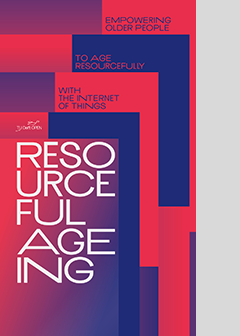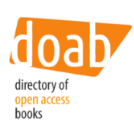Resourceful ageing: Empowering older people to age resourcefully with the Internet of Things
Keywords:
product design, aging in place, resourcefullness, care technology, Internet of Things, thing ethnography, machine learningSynopsis
In products designed specifically for older people, the inventiveness and resourcefulness of the elderly is often underestimated in favour of designs that overestimate the extent to which older people are in need of assistance. This book is about what older people can still do. The book describes an award-winning project that combined design experimentation, machine learning, and ethnographic fieldwork to create and prototype designs that could support older people in everyday practices of resourcefulness. The results offer the reader a categorized set of strategies for supporting resourcefulness in older people’s everyday lives; methodological considerations on algorithmic design practices and the role of machine learning in support of improvisation; and, relevant design tools and techniques. The book concludes with reflections on the importance of designing technology for older people not as ‘intervention’, but as ‘resources’. If designers want to support ageing in place, they must empower older people to configure technology with a higher degree of freedom. Editors: Elisa Giaccardi, Iohanna Nicenboim Authors: Elisa Giaccardi, Iohanna Nicenboim, Lenneke Kuijer, Louis Neven, Hayley Hung, Ivo Maathuis, Yanxia Zhang, Benjamin Lopez
Downloads
References
Aceros, J., Pols, J., & Domenèch, M. (2015). Where is grandma? Home telecare, good aging and the domestication of later life. Technological Forecasting and Social Change, 93, 102 - 111. https://doi.org/10.1016/j.techfore.2014.01.016
Akrich, M. (1992). The description of technical objects. In W. Bijker & J. Law (Eds.), Shaping Technology/Building Society: Studies in Sociotechnical Change (pp. 205 - 224). Cambridge, MA: MIT Press.
Chang, W.W., Giaccardi, E., Chen, L.L., Liang, R.H. (2017). Interview with things: A first-thing perspective to understand the scooter's everyday socio-material network in Taiwan. In Proceedings of the 2017 Conference on Designing Interactive Systems, 1001 - 1012. New York: ACM Press https://doi.org/10.1145/3064663.3064717
Colombo, M., Vitali, S., Molla, G., Gioia, P., & Milani, M. (1998). The home environment modification program in the care of the demented elderly: Some examples. Archives of Gerontology and Geriatrics, 26(1), 83 - 90. https://doi.org/10.1016/S0167-4943(98)80015-0
Durick, J., Robertson, T., Brereton, M., Vetere, F., & Nansen, B. (2013). Dispelling ageing myths in technology design. In Proceedings of the 25th Australian Computer-Human Interaction Conference: Augmentation, Application, Innovation, Collaboration (OzCHI'13), New York: ACM Press, 467 - 476. https://doi.org/10.1145/2541016.2541040
EFORTT, Ethical framework for telecare. Retrieved June 4, 2018 from http://www.lancaster.ac.uk/efortt/.
Fozard, J.L. (2002). Gerontechnology: Beyond Ergonomics and Universal Design. Gerontechnology, 1(3), 137 - 139 https://doi.org/10.4017/gt.2001.01.03.001.00
Fusaro, E. (2016). Resourceful Ageing. Master thesis. Delft, Netherlands: Delft University of Technology.
Giaccardi, E. (2018). Things making things: How things will help us design the internet of reinvented things. IEEE Pervasive Computing, 17(3). https://doi.org/10.1109/MPRV.2018.03367737
Giaccardi, E. (2019). Casting things in design as partners. In H. Wiltse (Ed.) Relating to Things that Relate to Us. Bloomsbury Academics (forthcoming).
Giaccardi, E. (2019). From products to changing things: Conceptualizing the role of the artifact in data-enabled Research through Design. International Journal of Design (forthcoming).
Giaccardi, E., Cila, N., Speed, C., & Caldwell, M. (2016). Thing ethnography: Doing design research with non-humans. In Proceedings Designing Interactive Systems 2016, 377 - 387. New York: ACM Press. https://doi.org/10.1145/2901790.2901905
Giaccardi, E., Kuijer, L., & Neven, L. (2016). Design for resourceful ageing: Intervening in the ethics of gerontechnology. In Proceedings of DRS 2016, Design Research Society 50th Anniversary Conference, Brighton, UK, 27-30 June 2016. https://doi.org/10.21606/drs.2016.258
Giaccardi, E., Speed, C., Cila, N., & Caldwell, M. (2016). Things as co-ethnographers: Implications of a thing perspective for design and anthropology. In R.C. Smith et al. (Eds.), Design Anthropological Futures, 235 - 248. Bloomsbury Academics. https://doi.org/10.4324/9781003085188-19
https://mailchi.mp/fastforwardlabs whats-data-ethnography-and-why-it-matters-improved-scalable-and-objective-evalua-tion-of-topic-models-adversarial-creation-of-beautiful-worlds?e=aa396b5575
Hyysalo, S. (2006). Representations of use and practice-bound imaginaries in auto-mating the safety of the elderly. Social Studies of Science, 36(4), 599 - 626. https://doi.org/10.1177/0306312706058426
Kitazaki, M. (2018). Connected Resources: A Research through Design Approach to Designing for Older People's Resourcefulness. Master thesis. Delft, Netherlands: Delft University of Technology.
Kuijer, L., Nicenboim, I., & Giaccardi, E. (2017). Conceptualising resourcefulness as a dispersed practice. In Proceedings of Designing Interactive Systems Conference 2017, 15 - 27. New York: ACM Press https://doi.org/10.1145/3064663.3064698
Mort, M., Milligan, C., Roberts, C., & Moser, I. (2008). Ageing, Technology and Home Care: New Actors, New Responsibilities. Paris: Presses de l'École des Mines de Paris. https://doi.org/10.4000/books.pressesmines.1492
N., Tynan-O'Mahony, F., Speed, C. (2015). Listening to an everyday kettle: How can the data objects collect be useful for design research? In Proceedings of the 4th Participatory Innovation Conference (PIN-C 2015), 500 - 506. The Hague, Netherlands: The Hague University of Applied Sciences.
Nationaal Ouderenfonds (2018, June 4). Facts and figures about the elderly in the Netherlands and the problems they face. Retrieved from https://www.ouderenfonds.nl/onze-organisatie/feiten-en-cijfers/.
Neven, L. (2010). 'But obviously not for me': Robots, laboratories and the defiant identity of elder test users. Sociology of Health and Illness, 32(2), 335 - 347. https://doi.org/10.1111/j.1467-9566.2009.01218.x
Neven, L. (2015). By any means? Questioning the link between gerontechnological innovation and older people's wish to live at home. Technological forecasting and social change, 93, 32 - 43. https://doi.org/10.1016/j.techfore.2014.04.016
Neven, L. (2015). Innoveren voor Actieve Ouderen: zachte Analyses als Handreiking voor Harde en Hardnekkige Problemen. Lectorale Rede, 6 februari 2015, Avans Hogeschool, Breda.
Neven, L., & Peine, A. (2017). From triple win to triple sin: How a problematic future discourse is shaping the way people age with technology. Societies, 7(26). https://doi.org/10.3390/soc7030026
Neven, L.B.M., & Maathuis, I.J.H. (2018, May 14). Hoe een Magneetje Je Vitaal Kan Houden. Retrieved June 4, 2018 from http://activeageing.nl/hoe-een-magneet-je-je-vitaal-kan-houden/
Nicenboim, I., Giaccardi, E., & Kuijer, L., (2018). Designing Connected Resources for Older People. In Proceedings of the 2018 CHI Conference on Human Factors in Computing Systems, 413 - 425. New York: ACM Press. https://doi.org/10.1145/3196709.3196808
Nicenboim, I., Kitazaki, M., Kihara, T., Torralba Marin, A., & Havranek, M. (2018). Connected Resources: A novel approach in designing technologies for older people.In Extended Abstracts of the 2018 CHI Conference on Human Factors in Computing Systems, Paper No. D202. New York:ACM Press. https://doi.org/10.1145/3170427.3186527
Östlund, B. (2005). Design paradigms and misunderstood technology: The case of older users. In Jaeger, B. (Ed.) Young Technologies in Old Hands: An International View on Senior Citizen's Utilization of ICT. DJØF Publishing Copenhagen, 25 - 39
Peine, A. & Neven, L. (2011). Socio-struc-tural lag revisited. Gerontechnology, 10(3), 129 - 139. https://doi.org/10.4017/gt.2011.10.3.002.00
Peine, A., & Neven, L. (2018). From inter-vention to co-constitution: New directions in theorizing about aging and technology. Gerontologist (forthcoming). https://doi.org/10.1093/geront/gny050
Peine, A., Rollwagen, I., & Neven, L. (2014). The rise of the "innosumer"- Rethinking older technology users. Technological Forecasting and Social Change, 82, 199 - 214. https://doi.org/10.1016/j.techfore.2013.06.013
Rogers, Y., & Marsden, G. (2013). Does he take sugar?: Moving beyond the rhetoric of compassion. ACM Interactions, 20(4), 48 - 57. https://doi.org/10.1145/2486227.2486238
Stappers, P. J., & Giaccardi, E. (2017). Research through design. In M. Soegaard & R. Friis-Dam (Eds.), The encyclopedia of human-computer interaction, 2nd Ed. Interaction Design Foundation.
StatLine (2018, June 4). Key figures of various population prognoses and observation. Retrieved from https://opendata.cbs.nl/#/CBS/nl/dataset/70737ned/table?ts=1528104150886
Thompson, P. (1992). 'I don't feel old': Subjective ageing and the search for meaning in later life. Ageing and Society, 12, 23 - 47 https://doi.org/10.1017/S0144686X00004657
Zhang, Y., & Hung, H. (2018) Using topic models to mine everyday object usage routines through connected IoT sensors, arXiv preprint arXiv:1807.04343 https://doi.org/10.1145/3277593.3277634





